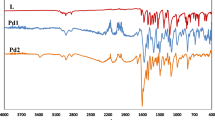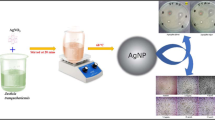Abstract
Curcumin [(1E, 6E)-1,7-bis(4-hydroxy-3-methoxy-phenyl)-1,6-heptadiene-3,5-dione] is a low molecular weight yellow-orange polyphenolic pigment extracted from the powdered rhizome of Curcuma longa. Curcumin has wide medicinal applications as an antioxidant, anti-inflammatory, cancer chemopreventive, and potentially chemotherapeutic agents as well as stabilizer/reducing agent in silver nanoparticles (AgNPs) synthesis. However, the low solubility of curcumin in aqueous solutions limits its applications and also, many of AgNP synthetic processes lack a greener synthetic route. In the present work, a Schiff base of curcumin is synthesized condensing curcumin and 1,4-diaminobutane in 2:1 ratio. The resulting product shows improvement in solubility in water and favours the synthesis of AgNPs in aqueous medium at room temperature, acting as a self-reducing/stabilizing agent. This proposed synthetic route is simple, feasible and green. The size and morphology of AgNPs are analyzed by TEM, SEM, EDS and XRD techniques. The recyclable AgNPs as a heterogeneous catalyst in the reduction of nitroaromatics to amino compounds is environmentally benign and can be re-used up to 5th cycle without considerable loss of its catalytic activity. Moreover, both Cur-1,4 and AgNPs show bactericidal properties against bacterial strains (Bacillus subtilis, Staphylococcus aureus, Escherichia coli and Pseudomonas aeruginosa) which find medicinal importance in future.
Graphic abstract
A greener approach has been proposed for the preparation of AgNPs stabilized on curcumin based Schiff base. The AgNPs finds applications as efficient, easily recyclable heterogenous catalyst in the reduction of nitroaromatics to environmentally benign aminoaromatics as well as an antibacterial agent.










Similar content being viewed by others
References
Jayaprakasha G K, Rao L J and Sakariah K K 2006 Antioxidant activities of curcumin, demethoxycurcumin and bisdemethoxycurcumin Food Chem. 98 720
Anderson A M, Mitchell M S and Mohan R S 2000 Isolation of curcumin from turmeric J. Chem. Edu. 77 359
Chan M M Y 1995 Inhibition of tumor necrosis factor by curcumin, a phytochemical Biochem. Pharmacol. 49 1551
Pan K, Zhong Q and Baek S J 2013 Enhanced dispersibility and bioactivity of curcumin by encapsulation in casein nanocapsules J. Agric. Food Chem. 61 6036
Ringman J M, Frautschy S A, Cole G M, Masterman D L and Cummings J L 2005 A potential role of the curry spice curcumin in Alzheimer’s disease Curr. Alzheimer Res. 2 131
Mohanty C, Acharya S, Mohanty A K, Dilnawaz F and Sahoo S K 2010 Curcumin-encapsulated MePEG/PCL diblock copolymeric micelles: a novel controlled delivery vehicle for cancer therapy Nanomedicine 5 433
Fathima N N, Devi R S, Rekha K B and Dhathathreyan A 2009 Collagen-curcumin interaction- A physico-chemical study J. Chem. Sci. 121 509
Sherin D R and Rajasekharan K N 2016 Curcuminoid-derived 3,5-bis(stryl)isoxazoles-Mechanochemical synthesis and antioxidant activity J. Chem. Sci. 128 1315
Monroy A, Lithgow G J and Alavez S 2013 Curcumin and neurodegenerative diseases Biofactors 39 122
Aggarwal B B, Kumar A and Bharti A C 2003 Anticancer potential of curcumin: preclinical and clinical studies Anticancer Res. 23 363
Sun Y M, Zhang H Y, Chen D Z and Liu C B 2002 Theoretical elucidation on the antioxidant mechanism of curcumin: a DFT study Org. Lett. 4 2909
Simon A, Allais D P, Duroux J L, Basly J P, Durand-Fontanier S and Delage C 1998 Inhibitory effect of curcuminoids on MCF-7 cell proliferation and structure-activity relationships Cancer Lett. 129 111
Sahu P K 2016 Design, structure activity relationship, cytotoxicity and evaluation of antioxidant activity of curcumin derivatives/analogues Eur. J. Med. Chem. 121 510
Kundu S and Nithiyanantham U 2013 In situ formation of curcumin stabilized shape-selective Ag nanostructures in aqueous solution and their pronounced SERS activity RSC Adv. 3 25278
Sharma R A, Gescher A J and Steward W P 2005 Curcumin: the story so far Eur. J. Cancer 41 1955
Wang D, Veena M S, Stevenson K, Tang C, Ho B, Suh J D and Wang M B 2008 Liposome-encapsulated curcumin suppresses growth of head and neck squamous cell carcinoma in vitro and in xenografts through the inhibition of nuclear factor \(\kappa \)B by an AKT-independent pathway Clin. Cancer Res. 14 6228
Gupta V, Aseh A, Ríos C N, Aggarwal B B and Mathur A B 2009 Fabrication and characterization of silk fibroin-derived curcumin nanoparticles for cancer therapy Int. J. Nanomed. 4 115
Das R K, Kasoju N and Bora U 2010 Encapsulation of curcumin in alginate-chitosan-pluronic composite nanoparticles for delivery to cancer cells Nanomed. 6 153
Maiti K, Mukherjee K, Gantait A, Saha B P and Mukherjee P K 2007 Curcumin–phospholipid complex: preparation, therapeutic evaluation and pharmacokinetic study in rats Int. J. Pharm. 330 155
Yallapu M M, Jaggi M and Chauhan S C 2010 Poly (\(\beta \)-cyclodextrin)/Curcumin Self-Assembly: A Novel Approach to Improve Curcumin Delivery and its Therapeutic Efficacy in Prostate Cancer Cells Macromol. Biosci. 10 1141
Massaro M, Amorati R, Cavallaro G, Guernelli S, Lazzara G, Milioto S and Riela S 2016 Direct chemical grafted curcumin on halloysite nanotubes as dual-responsive prodrug for pharmacological applications Colloid. Surf. B 140 505
Chandrasekar T, Pravin N and Raman N 2014 Biosensitive metal chelates from curcumin analogues: DNA unwinding and anti-microbial evaluation Inorg. Chem. Commun. 43 45
Fang L, Gou S, Liu X, Cao F and Cheng L 2014 Design, synthesis and anti-Alzheimer properties of dimethylaminomethyl-substituted curcumin derivatives Bioorg. Med. Chem. Lett. 24 40
Fang X, Fang L, Gou S and Cheng L 2013 Design and synthesis of dimethylaminomethyl-substituted curcumin derivatives/analogues: Potent antitumor and antioxidant activity, improved stability and aqueous solubility compared with curcumin Bioorg. Med. Chem. Lett. 23 1297
Zhang L, Yu J C, Yip H Y, Li Q, Kwong K W, Xu A W and Wong P K 2003 Ambient light reduction strategy to synthesize silver nanoparticles and silver-coated TiO2 with enhanced photocatalytic and bactericidal activities Langmuir 19 10372
Gong C, Wu Q, Wang Y, Zhang D, Luo F, Zhao X and Qian Z 2013 A biodegradable hydrogel system containing curcumin encapsulated in micelles for cutaneous wound healing Biomaterials 34 6377
Panáček A, Kvitek L, Prucek R, Kolář M, Večeřová R, Pizúrová N and Zbořil R 2006 Silver colloid nanoparticles: synthesis, characterization, and their antibacterial activity J. Phys. Chem. B 110 16248
Chou K S and Ren C Y 2000 Synthesis of nanosized silver particles by chemical reduction method Mater. Chem. Phys. 64 241
Huang H H, Ni X P, Loy G L, Chew C H, Tan K L, Loh F C and Xu G Q 1996 Photochemical formation of silver nanoparticles in poly(N-vinylpyrrolidone) Langmuir 12 909
Zhang Z, Zhao B and Hu L 1996 PVP protective mechanism of ultrafine silver powder synthesized by chemical reduction processes J. Solid State Chem. 121 105
Chen M, Wang L Y, Han J T, Zhang J Y, Li Z Y and Qian D J 2006 Preparation and study of polyacryamide-stabilized silver nanoparticles through a one-pot process J. Phys. Chem. B 110 11224
Chou C W, Hsu S H, Chang H, Tseng S M and Lin H R 2006 Enhanced thermal and mechanical properties and biostability of polyurethane containing silver nanoparticles Polym. Degrad. Stab. 91 1017
Lee M H, Oh S G, Suh K D, Kim D G and Sohn D 2002 Preparation of silver nanoparticles in hexagonal phase formed by nonionic Triton X-100 surfactant Colloid. Surf. A 210 49
Liz-Marzán L M and Lado-Touriño I 1996 Reduction and stabilization of silver nanoparticles in ethanol by nonionic surfactants Langmuir 12 3585
Raveendran P, Fu J and Wallen S L 2003 Completely “green” synthesis and stabilization of metal nanoparticles J. Am. Chem. Soc. 125 13940
Mandal S, Selvakannan P R, Pasricha R and Sastry M 2003 Keggin ions as UV-switchable reducing agents in the synthesis of Au core- Ag shell nanoparticles J. Am. Chem. Soc. 125 8440
Patolsky F, Lichtenstein A and Willner I 2001 Electronic transduction of DNA sensing processes on surfaces: amplification of DNA detection and analysis of single-base mismatches by tagged liposomes J. Am. Chem. Soc. 123 5194
Pastoriza-Santos I and Liz-Marzán L M 2002 Synthesis of silver nanoprisms in DMF Nano Lett. 2 903
El Khoury E, Abiad M, Kassaify Z G and Patra D 2015 Green synthesis of curcumin conjugated nanosilver for the applications in nucleic acid sensing and anti-bacterial activity Colloid. Surf. B 127 274
Verma A D, Jain N, Singha S K, Quraishi M A and Sinha I 2016 Green synthesis and catalytic application of curcumin stabilized silver nanoparticles J. Chem. Sci. 128 1871
Singh D K, Jagannathan R, Khandelwal P, Abraham P M and Poddar P 2013 In situ synthesis and surface functionalization of gold nanoparticles with curcumin and their antioxidant properties: an experimental and density functional theory investigation Nanoscale 5 1882
Bhatia N K, Kishor S, Katyal N, Gogoi P, Narang P and Deep S 2016 Effect of pH and temperature on conformational equilibria and aggregation behaviour of curcumin in aqueous binary mixtures of ethanol RSC Adv. 6 103275
He L, Wu H, Gao S, Liao X, He Q and Shi B 2012 Silver nanoparticles stabilized by tannin grafted collagen fiber: synthesis, characterization and antifungal activity Ann. Microbial. 62 319
Maity D, Bain M K, Bhowmick B, Sarkar J, Saha, S, Acharya K and Chattopadhyay D 2011 In situ synthesis, characterization, and antimicrobial activity of silver nanoparticles using water soluble polymer J. Appl. Polym. Sci. 122 2189
Xu R, Wang D, Zhang J and Li Y 2006 Shape-dependent catalytic activity of silver nanoparticles for the oxidation of styrene Chem. Asian J. 1 888
Zhang K, Suh J M, Choi J W, Jang H W, Shokouhimehr M and Varma R S 2019 Recent advances in the nanocatalyst-assisted \(\text{NaBH}_{{4}}\) reduction of nitroaromatics in water ACS Omega 4 483
Bhosale M A, Chenna D R and Bhanage B M 2017 Ultrasound assisted synthesis of gold nanoparticles as an efficient catalyst for reduction of various nitro compounds ChemistrySelect 2 1225
An Q, Yu M, Zhang Y, Ma W, Guo J and Wang C 2012 \(\text{Fe}_{{3}}\text{O}_{{4}}\)@Carbon microsphere supported Ag-Au bimetallic nanocrystals with the enhanced catalytic activity and selectivity for the reduction of nitroaromatic compounds J. Phys. Chem. C 116 22432
Kästner C and Thünemann A F 2016 Catalytic reduction of 4-nitrophenol using silver nanoparticles with adjustable activity Langmuir 32 7383
Chen S, Wu G and Zeng H 2005 Preparation of high antimicrobial activity thiourea chitosan–\(\text{ Ag }^{+}\) complex Carbohyd. Polym. 60 33
Acharya D, Singha K M, Pandey P, Mohanta B, Rajkumari J and Singha L P 2018 Shape dependent physical mutilation and lethal effects of silver nanoparticles on bacteria Sci. Rep. 8 201
Basniwal R K, Buttar H S, Jain V K and Jain N 2011 Curcumin nanoparticles: preparation, characterization, and antimicrobial study J. Agric. Food Chem. 59 2056
Acknowledgements
The authors are grateful to the Department of Science and Technology, Govt. of India, for financial assistance under DST-FIST programme and UGC, New-Delhi for Special Assistance Program (SAP-DRS) to the Department of Chemistry, Dibrugarh University. The authors are also grateful to Sophisticated Analytical Instrument Facility (SAIF), NEHU, Shillong, IASST, Guwahati, CSIR NEIST, Jorhat and SAIF, IIT Bombay for spectral analysis and Department of Pharmaceutical sciences, Dibrugarh University for in vitro antibacterial studies. NG is thankful to Dibrugarh University for Dibrugarh University Research Fellowship.
Author information
Authors and Affiliations
Corresponding author
Electronic supplementary material
Below is the link to the electronic supplementary material.
Rights and permissions
About this article
Cite this article
GOGOI, N.G., HANDIQUE, J.G. Novel protocol for synthesis of 1,4-diiminocurcumin stabilized silver nanoparticles and application as heterogenous recyclable catalyst and antibacterial agent. J Chem Sci 131, 74 (2019). https://doi.org/10.1007/s12039-019-1654-1
Received:
Revised:
Accepted:
Published:
DOI: https://doi.org/10.1007/s12039-019-1654-1




